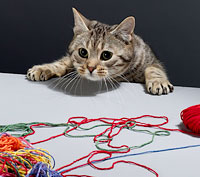Many people hang on to outdated or just plain wrong information about what can be dangerous to domestic animals. And once we've got these myths in our minds, it can be hard to let them go. At the same time, many of us aren't aware of very real dangers our pets encounter in our homes — ones that you can easily avoid once you know about them.
As a practicing veterinarian with more than 30 years' experience, I've got the latest information to help you separate the myths from the facts:
Myth: Chocolate is lethal in a small amount. I know this may surprise you, because you've heard it all your life, but your Labrador isn't going to drop dead after nibbling on a chocolate bar. A large dog would have to eat a lot of milk chocolate to get ill — more than a couple of pounds. That doesn't mean there's no risk to chocolate at all: The darker chocolate is and the smaller the dog, the more dangerous the substance can be. So don't give chocolate as a treat — but don't panic if your pet ingests a small bit.
Fact: Sugar-free sweetener is the real danger. Xylitol is a popular sweetener in sugar-free gums and candies, but it's deadly to pets. And, sadly, it's often very easy for dogs and cats to get a lethal dose after pulling some gum out of a guest's purse or snarfing up some sugar-free candies from a decorative bowl. So enjoy your low-cal goodies, but make sure to keep them out of your pet's reach.
Myth: Poultry bones mean a trip to the ER. I'm not suggesting you feed your chicken bone leftovers to your pet, but if your pooch chows down on one, don't worry. Most dogs will digest raw poultry bones without any problem. Cooked ones are a little more problematic because they have a tendency to splinter. Talk to your veterinarian if your pet shows any sign of illness, but don't freak out otherwise.

— Janie Airey/Getty Images
Fact: Yarn balls are dangerous for cats. Any kind of stringy object — yarn, ribbon, thread or even the juice-saturated string from a roast — can be dangerous to cats. Yes, they're attracted to such things, but if they eat them, as a playful kitten might, they often need surgery to save their lives. Be sure to keep a lid on your garbage and put all hobby projectssafely away when you're not working on them.
Myth: You need to avoid certain cleaning products. If you're a pet owner, chances are good that someone has forwarded you e-mails about a dog or cat who died after coming in contact with Febreze or Swiffer products. No one knows where these rumors started, but they've been floating around for so long that the ASPCA's Animal Poison Control Center looked at the claims. The bottom line: Both products are safe around pets when used as directed. (A good place to check on the reliability of e-mail information is on the Poison Control Center's websiteor on Snopes.com.)
Myth: Poinsettia leaves are poison. With holidays on the way, now's a good time to bring up the widespread idea that this traditional holiday greenery is poisonous. It's not: The worst your pet will get is a stomachache. If you like these plants, enjoy them in your home without worry.
Fact: Lilies can be lethal. Now that you've cleared some space in your mind by not worrying about poinsettias, put lilies in that spot. These flowers are pretty in the house or yard, but if you have pets, you're better off avoiding them, since pets can die from eating any part of the plant.
Have a question about your pet? Join Dr. Becker in AARP's PetPals online community group.
No comments:
Post a Comment